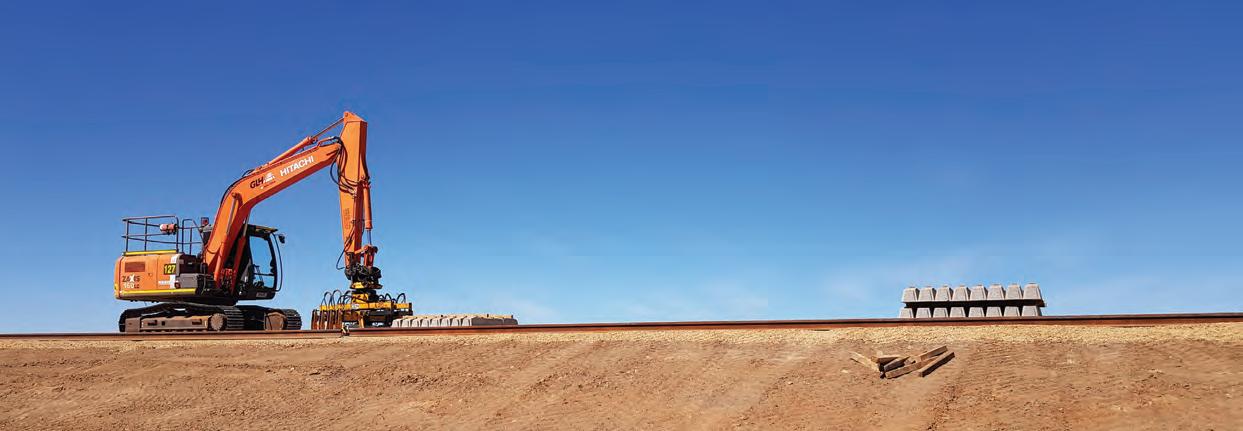
4 minute read
GLH the rail problem-solvers
Plant, Machinery and Equipment
Problem solving for rail projects
Brisbane-based rail and civil plant hire firm George’s Loader Hire is expanding its manufacturing operations to meet demand for specialised equipment in Queensland’s transport infrastructure sector.
In 1994, George Baird established a front end loader hire business with the purchase of two loaders from a local businessman in South East Queensland. With the support of his wife Shaneen, Baird grew the business to a fleet of 20 machines with major customers in rail, recycling and materials handling.
Kelly Cooke, director of George’s Loader Hire (GLH), says her father’s passing 12 years ago marked the end of an era, and motivated the GLH family to grow into one of Queensland Rail ’s leading plant and equipment suppliers.
“We are proud of our track record on Queensland’s major rail construction projects, having played a part in every major project over the last two decades,” Cooke says.
This includes work on rail upgrade projects Corinda to Darra, Richlands to Springfield, and construction projects such as Moreton Bay Rail Link and the Gold Coast Light Rail.
Currently, the company is busy with regional Queensland Rail maintenance work , Cross River Rail and supplying wet hire excavator laying sleepers and dry hire loaders for the Carmichael Rail Network.
Cooke says providing highly experienced operators is crucial for increasing efficiencies and eliminating downtime on site.
“Many of our operators have worked with us for 10 years,” she says. “We invest in our operators like we do our equipment, we can’t have one without the other. Having the big projects on your resume is so important because it means you have the experienced operators to meet a client’s needs.”
GLH now boasts a range of tri-gauge equipment for Inland Rail, including standard, broad and narrow gauge hi rail excavators, trolleys, brooms, sleeper layers and narrow gauge dumpers. The rail equipment hire firm’s fleet of machines is unique to its customer’s requirements, according to Cooke.
“Our machinery has many uses and we aim to provide solutions to our customers, not just the bare bones equipment,” she says. “The management team has decades of experience in rail and with our in-house engineer we are able to work with customers to innovate and manufacture workable solutions to difficult problems.”
Operating from its maintenance workshop in the outer Brisbane suburb of Willawong, GLH designs prototypes to test on its own equipment so it’s ready for the field.
“Designing solutions for unique scenarios is our point of difference,” Cooke adds. “It’s how we are able to offer special solutions to customers with specific problems. For example, one of our customers couldn’t get ballast into a tunnel entrance so we designed and manufactured a special purpose bin to sit on one of our trigauge rail trolleys.”
For another project, GLH designed a special attachment for a hi rail excavator used with a rail trailer, to transport rigid catanery steel work into a central tunnel and lift it into the central rail tunnel in Brisbane CBD safely.
These success stories prompted GLH to increase its manufacturing capacity by establishing a new company called Specialised Rail Solutions (SRS) last year. Cooke herself is a director along with Cameron Baird and, together, they recently double downed on innovation investment by purchasing a small engineering business under SRS.
Cooke sees the purchase of Quality Assured Engineering and a new manufacturing facility as an opportunity to expand on GLH’s history of supplying rail attachments and innovation.
“We want to continue to be innovators in this field,” she says. “By putting energy into the manufacturing side of our business into this new company, we want to meet the increasing demand for our attachments.”
The new premises in Browns Plains will also increase capacity to manufacture GLH’s popular height limit systems.
The in-house designed systems use modern sensor technology to give machines more functionality whilst meeting Queensland Rail spec requirements and being easy for the operators to use.
Cooke says Queensland’s change in rail standards around four years ago sparked a system upgrade.
“We couldn’t find a suitable and wellpriced product off the shelf to meet the new standards,” she says. “In the process we developed not only a functional height limiter system for earthmoving equipment, but also a revolutionary sensor design which will have far reaching applications on mobile plant safety systems of all kinds, beyond height limiters.”
Moving forward, Cooke hopes to acquire a functional safety rating so the height limiter systems can branch into different markets.
“We believe the product will go through the third-party certification to achieve the functional safety,” she says. “We’re hoping this will create a potential for international marketing opportunities because we know there is great demand for the technology.”
GLH laying sleepers for the Carmichael Rail Network. Many of GLH’s equipment operators have decades of experience.








